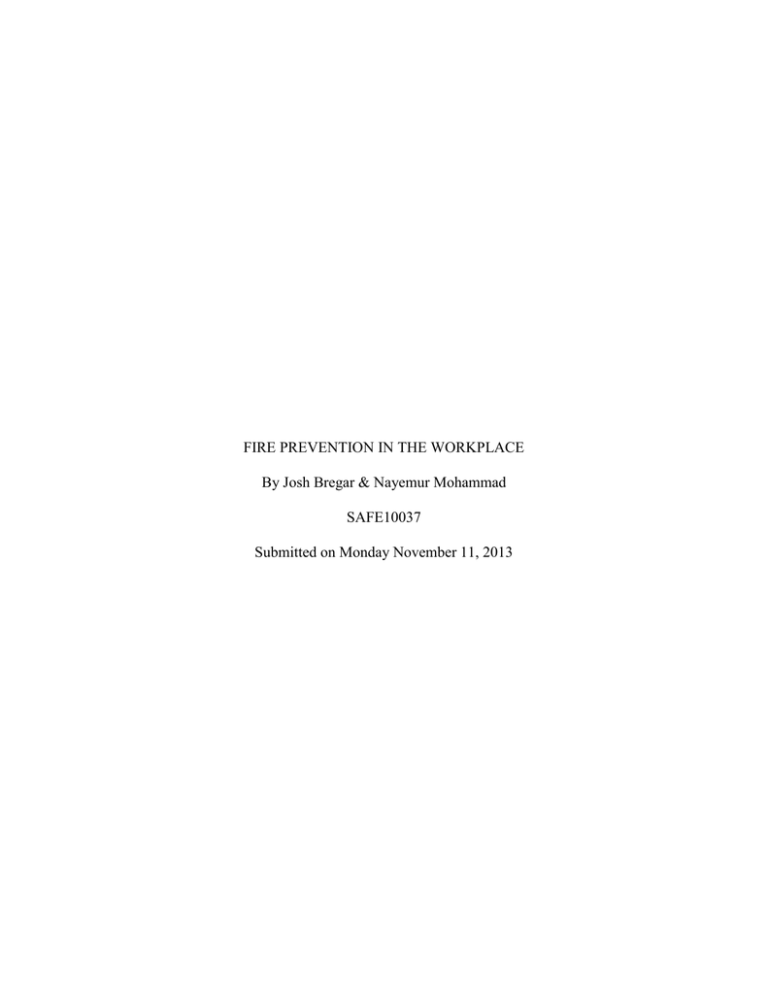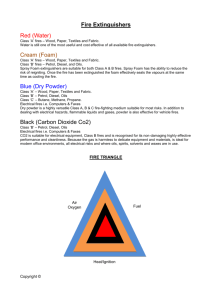Fire Prevention in the workplace research
advertisement

FIRE PREVENTION IN THE WORKPLACE By Josh Bregar & Nayemur Mohammad SAFE10037 Submitted on Monday November 11, 2013 Table Of Contents 1. 2. 3. 4. 5. 6. 7. 8. 9. Title Page..............................................................................pg.1 Table of Contents..................................................................pg.2 Introduction to Workplace Fire Safety………………………..pg.3, paragraph 1 Common Causes of Fire In Workplace……………………...pg.3-4, paragraph 2-4 Importance Of Topic…………………………………………..pg.4, paragraph 5 Fire extinguishers……………………………………………...pg.4-5, paragraph 6-15 Prevention of Fire In Workplace………………………………pg.6, paragraph 16-17 Conclusion……………………………………………………..pg.6-7, paragraph 18 References…………………………………..………………...pg.8 Fire prevention and safety is vital in all workplaces. In fact, Fire Prevention Canada (FIPRECAN) reported that on average, eight people die from fires each week in Canada, with 37% of these fatalities coming from workplace environments. 7Although fires do not occur as often as some workplace accidents such as slips and falls, fires have the potential to have catastrophic repercussions on both businesses and employees. This report topic will cover the various types of workplace fires and how they can be started along with tools used to fight each type of fire. In addition, essential fire prevention measures will be explored in order to prevent these serious hazards from ever starting. 70,000 Faulty Fuel Supplies 60,000 Faulty Appliances & Leads 50,000 Misuse of Equipment or Appliances 40,000 Chip/Fat Pan Fires 30,000 Playing with fire 20,000 Careless Handling of Fires or Hot Substances 10,000 Placing Articles too close to heat 0 Category 1 Other Accidental Figure 1 Causes of accidental fires in buildings other than dwellings 2000-2010 Workplace fires can happen anytime and for the smallest reasons. One common fire starter in the workplace is by chemical reactions in labs and in industries. A student in Melbourne University was working on a chemistry lab, during the lab one of the reactions caused the glass instrument to explode,. Which resulted in severe hand injuries and a fire. 1 Other common ways of starting fires at workplaces are electricity, by compressed gasses and smoke or smoking.2 Another example would be a fire in the cheesecake factory in Waikiki. The fire was believed to have started from a gas leak in the fryer causing it to explode. It caused 2.5 million dollars in damages.3 A common way fires get started in a workplace is electrically. Due to faulty wiring and circuits. Electrical fires can be started by: Live wires coming to contact with flammable objects Combustion of transformers Shorting a circuit (a disturbance in the circuit that causes current to flow in a unwanted path) In addition to electrical fires, another common one is spontaneous combustion fires. These typically occur between a reaction of two or more substances. For example, in St. Boniface, Winnipeg, a fire was started from an accidental combustion of an Figure 2 Speedway fuels explosion in Boniface, WIN unknown oil substance. 4 Other causes of combustion are: Compressed gasses Chemical reactions Poor cleanup Leaks in pipe lines(particularly gas pipes) Unwanted heating of gases 4 These are important examples because in the chemical engineering field, we are required to perform experiments and tasks containing hazardous chemicals, compressed gasses and other hazardous materials that may cause a fire if not cautious. These examples and safety tips concern us because as chemical engineering students it is required for us to know the proper procedure of doing things to avoid and control any fire hazards. With all of the different classes of fires, it is important to be prepared for the ones that can occur in your specific workplace, for example, a restaurant kitchen has different fire hazards than a chemical processing plant. So it is vital to have the proper fire extinguishing tools to be able to handle all the potential fires your workplace may have. Below is a table of each type of fire extinguisher and what fire they are specialized in to fight against. Class A fires consist of ordinary combustibles such as wood, paper, trash or anything else that leaves an ash. Although each type of fire extinguisher above with the exception of the CO2 extinguisher can put out a Class A fire, the water based extinguishers works best to extinguish a Class A fire. 2 Class B Fires are fueled by flammable or combustible liquids, which include oil, gasoline, and other similar materials. These can often occur in gas stations, oil refineries or even restaurant kitchens. These fires can be smothered by extinguishers which deplete the oxygen supply such as CO2, Dry Powder, AFF Foam and Vapourising Liquid based extinguishers. 2 Class C fires are Energized Electrical Fires. In order to smother these fires you must always de-energize the circuit then use a non-conductive extinguishing agent. Such as Carbon dioxide extinguishers. 2 Class D Fires are combustible metal fires. Magnesium and Titanium are the most common types of metal fires. Once a metal ignites do not use water in an attempt to extinguish it. Only use a Dry Powder extinguisher. Dry powder agents work by smothering and heat absorption of the fire. 2 Class K fires are fires that involve cooking oils, grease or animal fat and can be extinguished using Purple K, the typical agent found in kitchen or galley extinguishers. Purple K is a drychemical fire suppressant found in some dry powder extinguishers. These fires are most commonly found in kitchen workplaces.2 Furthermore, safety blankets can be very effective to combat the early stages of class A, B, C and K fires. They work by covering the and preventing the fire continue due to a lack of oxygen. Lastly, in class A and K fires, you can actually throw salt and baking soda onto the early stages of a fire to help combat the flames. According to the Industrial Accident Prevention Association (IAPA), there are several conditions a workplace needs to meet in order for fire extinguishers to be effective in their workplace. First of all, the right fire extinguisher(s) need to be readily available in your work environment. 5 This means that the fire extinguisher has to be easily accessible, an example of this would be locations at all exit doors and areas where the risk of a fire to break out is more likely. Fire extinguishers are also to be used on the small, early stages of a fire by an individual who is trained to use it properly. Environment conditions need to be taken into account as some fire extinguishers may become ineffective, for example, water-based extinguishers in extreme cold environments could render ineffective (IAPA). 5 We have covered all of the topics necessary to control and smother a fire if one were to break out in the workplace. But the most important of all is the prevention of a fire in the first place. Prevention of fires is key to combating fires. Below are the responsibilities the employers have in order to maximize the prevention of fires. Employers are responsible for: Informing all employees about the fire safety plan Having fire emergency procedures on each floor Conducting regular fire drills with all employees Preparing a fire safety plan8 Figure 3 Fire Safety Plan Other ways to prevent a fire is to use CSA (Canadian Standards Association) approved tools like, power bars, appliances and wiring. These tools are approved by the CSA that have mechanisms to prevent short circuiting that can lead to a potential fire. Furthermore, avoid overloading an outlet with multiple extension cords and plugs. Finally, keep combustible materials and appliances and electronics a safe distance from each other and remove unwanted garbage and debris from your workplace that can prove to be a fire hazard.6 In order to maintain a safe workplace, the measures we have discussed play a vital role in obtaining that goal. Unfortunately Figure 4 Outlet overload causes fires accidents will happen, no matter how much you prepare for them. Therefore, it is crucial to be in a position to subdue these fire hazards as they happen with the proper fire extinguishers, fire alarms and other methods to prevent employee injuries and damage costs to businesses. Also, a fire safety plan should always be established in any workplace along with routine practices by both the employee and employer to assure the safety of everyone if a fire occurs. References 4 CBC News. (2012, October 12). Spontaneous combustion blamed for massive fuel plant fire. CBC News. Retrieved November 10, 2013, from http://www.cbc.ca/news/canada/manitoba/spontaneous-combustion-blamed-for-massivefuel-plant-fire-1.1233142 2 Classes of Fire - A, B, C, D, and K. (n.d.). Falck Alford Productions. Retrieved November 10, 2013, from http://www.falckproductions.com/resources/fire-safety-and-firewatch/classesof-fire-a-b-c-d-and-k/ 3 DiGiovanni, P. (2013, February 25). Cheesecake Factory reopens in Waikiki after fire. HawaiiNewsNow. Retrieved November 10, 2013, from http://www.hawaiinewsnow.com/story/21320156/cheesecake-factory-to-reopen-monday 5 Fire Extinguishers in the Workplace. (n.d.). IAPA. Retrieved November 10, 2013, from http://www.iapa.ca/pdf/FreeDownloads8_fireext.pdf 7Fire Prevention Canada Fact Sheet. (n.d.). Fire Prevention Canada. Retrieved November 9, 2013, from http://www.fiprecan.ca/index.php?section=2 6Fire 1 Prevention in Your Workplace. (n.d.). Safety Services Company. Retrieved November 10, 2013, from http://www.safetyservicescompany.com/topic/training/fire-prevention-inyour-workplace-getting-better-fire-safety-measures News.com.au. (2013, November 8). Student injured in Melbourne uni explosion. News.com. Retrieved November 10, 2013, from http://www.news.com.au/national/breakingnews/student-injured-in-melbourne-uni-explosion/story-e6frfku9-1226756107455 Causes of fires chart reformatted to fit word from http://apollo600.seaward.co.uk/wpcontent/uploads/2013/05/Fire-statistics-chart.jpg

